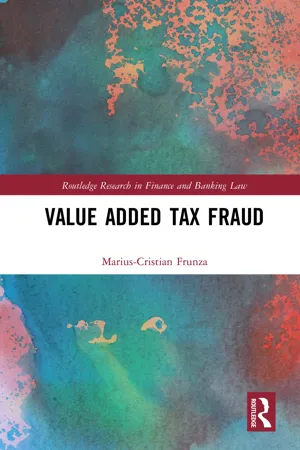
- 320 pages
- English
- ePUB (mobile friendly)
- Available on iOS & Android
Value Added Tax Fraud
About this book
Serving as an introduction to one of the "hottest" topics in financial crime, the Value Added Tax (VAT) fraud, this new and original book aims to analyze and decrypt the fraud and explore multi-disciplinary avenues, thereby exposing nuances and shades that remain concealed by traditional taxation oriented researches. Quantifying the impact of the fraud on the real economy underlines the structural damages propagated by this crime in the European Union. The 'fruadsters' benefit when policy changes are inflicted in an economic space without a fully fledged legal framework. Geopolitical events like the creation of the Eurasian Union and 'Brexit' are analyzed from the perspective of the VAT fraud, thereby underlining the foreseeable risks of such historical turnarounds. In addition, this book also provides a unique collection of case studies that depict the main characteristics of VAT fraud.
Introduction to VAT Fraud will be of interest to students at an advanced level, academics and reflective practitioners. It addresses the topics with regards to banking and finance law, international law, criminal law, taxation, accounting, and financial crime. It will be of value to researchers, academics, professionals, and students in the fields of law, financial crime, technology, accounting and taxation.
Frequently asked questions
- Essential is ideal for learners and professionals who enjoy exploring a wide range of subjects. Access the Essential Library with 800,000+ trusted titles and best-sellers across business, personal growth, and the humanities. Includes unlimited reading time and Standard Read Aloud voice.
- Complete: Perfect for advanced learners and researchers needing full, unrestricted access. Unlock 1.4M+ books across hundreds of subjects, including academic and specialized titles. The Complete Plan also includes advanced features like Premium Read Aloud and Research Assistant.
Please note we cannot support devices running on iOS 13 and Android 7 or earlier. Learn more about using the app.
1 Introduction to the mechanisms of VAT fraud
VAT: a European concept
- the tax levy base, representing the nominal value upon which the assessment of tax liability is made, and
- the tax rate, which is presented generally as a percentage.
Tax fraud
- Tax optimization consists of adjusting the various financial metrics comprising a base for tax levies in order to minimize the total tax liability. A simple example is using debt in corporate as a means to reduce the corporate tax bill.
- Tax arbitrage profits from the way a given transaction is taxed in different countries or different regions of a country. VAT for example has various rates in different countries. Within the same country a region (i.e., Livigno in Italy) could be exempted of tax.
- Tax avoidance is the practice that employs legal methods in order to aggressively reduce tax liability by claiming deduction or refunds. Tax avoidance can employ sophisticated structures like offshore holdings and structured financial products, like insurance or derivatives, designed to enhance tax avoidance.
VAT fraud typologies
- The formal economy, represented by those economic activities governed by the national law and with observable and quantifiable turnover figures. Traditionally, the formal economy is established on organized commercial entities registered with the national business registries. The size of the formal economy is measured from compulsory reports required by governments from businesses, including tax fillings, financial annual statements, etc.
- The informal or the shadow economy, encompassing all trades of goods and services taking place outside the perimeter of national laws. The volumes and the values of the trades for the shadow economy are in most of the cases not directly observable. The output of the shadow economy is not included in the base of any national tax.
- Shadow economy-related VAT fraud encompasses the undeclared domestic and cross-border trades of goods and services not submitted to VAT.
- Dissimulation of trades from formal economy is known as Missing trader fraud. The Missing trader’s aim of concealing the totality or part of the turnover is to underestimate the base of the VAT and to pay less or not to pay the full value of the liability towards the national treasury. The missing trader ‘disappears’ after a relatively short period of time by closing, abandoning or bankrupting the business.
- Misrepresenting the figures from the trading book of an organization by employing Accounting shenanigans aim to artificially reduce the amount of VAT liabilities, without altering the rest of the accounting figures. The accounting shenanigans can be used over an extended period of time, without ceasing the business, as in the case of the missing trader.
- Misrepresenting the type of traded goods or services aims to reduce the VAT liability by applying an inappropriate VAT rate lower than required. Misrepresentation of goods and services entails declaring for taxation purposes an item in a category different from the correct one in order to arbitrate the VAT rate percentage.
The shadow economy
Table of contents
- Cover
- Half Title
- Series Page
- Title Page
- Copyright Page
- Dedication
- Table of Contents
- List of figures
- List of tables
- Acknowledgements
- 1 Introduction to the mechanisms of VAT fraud
- 2 Markets and VAT fraud
- 3 Impact of the VAT fraud on the EU’s economy
- 4 Brexit effect on the VAT fraud
- 5 VAT: a modern economic weapon
- 6 How the VAT fraud proceeds are laundered
- 7 Perspectives upon the VAT fraud in the Eurasian Economic Union
- 8 The economy of terror: VAT fraud and terrorism financing
- 9 Technology: a real leverage for the VAT fraudsters
- 10 Who is who in the VAT milieu?
- 11 How the VAT fraud reshaped the criminal underworld
- 12 Investigating the VAT fraud
- 13 Avenues of countering VAT fraud
- Appendix
- Bibliography
- Index